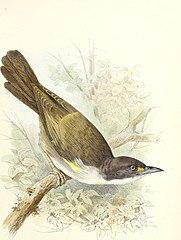Hispaniole
| Calyptophilidae | |||
| Ridgway, 1907 | |||
 Przedstawiciel rodziny – hispaniol oliwkowy (C. frugivorus) na ilustracji Charlesa Cory’ego opublikowanej w książce The Birds of Haiti and San Domingo z 1885 roku | |||
| Systematyka | |||
| Domena | |||
|---|---|---|---|
| Królestwo | |||
| Typ | |||
| Podtyp | |||
| Gromada | |||
| Podgromada | |||
| Infragromada | |||
| Rząd | |||
| Podrząd | |||
| Rodzina | hispaniole | ||
| Rodzaje | |||
Hispaniole[2] (Calyptophilidae) – monotypowa rodzina ptaków z podrzędu śpiewających (Oscines) w rzędzie wróblowych (Passeriformes).
Występowanie
Rodzina obejmuje gatunki występujące na wyspie Haiti[3].
Morfologia
Długość ciała 18–21 cm, masa ciała 26,3–55,3 g[4].
Systematyka
Etymologia
Nazwa rodzajowa Calyptophilus jest połączeniem słów z języka greckiego: καλυπτω kaluptō – „ukrywanie” oraz φιλος philos – „miłośnik, kochający”[5].
Gatunek typowy
Phoenicophilus frugivorus Cory
Podział systematyczny
Takson wyodrębniony do rangi rodziny na podstawie badań molekularnych[6][7]. Wcześniej zaliczany do tanagrowatych (Thraupidae)[4][8], hispaniolczyków (Phaenicophilidae)[9] lub lasówek (Parulidae)[2]. Do rodziny należy jeden rodzaj z następującymi gatunkami[2]:
- Calyptophilus tertius – hispaniol brązowawy
- Calyptophilus frugivorus – hispaniol oliwkowy
Przypisy
- ↑ Ch.B. Cory. Descriptions of several new birds from Santo Domingo. „The Auk”. 1, s. 3, 1884 (ang.).
- ↑ a b c Systematyka i nazwy polskie za: P. Mielczarek & M. Kuziemko: Rodzina: Calyptophilidae Ridgway, 1907 - hispaniole - Chat tanagers (wersja: 2019-05-02). W: Kompletna lista ptaków świata [on-line]. Instytut Nauk o Środowisku Uniwersytetu Jagiellońskiego. [dostęp 2021-07-11].
- ↑ F. Gill, D. Donsker & P. Rasmussen (red.): Caribbean “tanagers”, Wrenthrush, Yellow-breasted Chat (ang.). IOC World Bird List (v11.1). [dostęp 2021-07-11].
- ↑ a b S. Hilty: Family Thraupidae (Tanagers). W: J. del Hoyo, A. Elliott, D.A. Christie: Handbook of the Birds of the World. Cz. 16: Tanagers to New World Blackbirds. Barcelona: Lynx Edicions, 2011, s. 326. ISBN 978-84-96553-78-1. (ang.)
- ↑ Calyptophilus, [w:] The Key to Scientific Names, J.A. Jobling (red.), [w:] Birds of the World, S.M. Billerman et al. (red.), Cornell Lab of Ornithology, Ithaca [dostęp 2022-02-04] (ang.).
- ↑ F.K. Barker, K.J. Burns, J. Klicka, S.M. Lanyon, I.J. Lovette. Going to Extremes: Contrasting Rates of Diversification in a Recent Radiation of New World Passerine Birds. „Systematic Biology”. 62 (2), s. 298–320, 2013. DOI: 10.1093/sysbio/sys094 (ang.).
- ↑ F.K. Barker, K.J. Burns, J. Klicka, S.M. Lanyon, I.J. Lovette. New insights into New World biogeography: An integrated view from the phylogeny of blackbirds, cardinals, sparrows, tanagers, warblers, and allies. „The Auk”. 132 (2), s. 333–348, 2015. DOI: 10.1642/AUK-14-110.1 (ang.).
- ↑ F. Gill, D. Donsker (red.): Tanagers, flowerpiercers & tanager-finches (ang.). IOC World Bird List: Version 5.4. [zarchiwizowane z tego adresu (2015-12-20)].
- ↑ J.H. Boyd III: Phaenicophilidae: Palm-Tanager and allies (ang.). W: Aves—A Taxonomy in Flux 3.00f [on-line]. John Boyd's Home Page. [dostęp 2019-12-01].
Media użyte na tej stronie
Autor: (of code) -xfi-, Licencja: CC BY-SA 3.0
The Wikispecies logo created by Zephram Stark based on a concept design by Jeremykemp.
Autor:
Cory, Charles Barney;
Cory, Charles Barney, 1857-1921, Licencja: No restrictionsTitle: The Birds of Haiti and San Domingo
Identifier: birdsofhaitisand00cory (find matches)
Year: 1885 (1880s)
Authors: Cory, Charles Barney; Cory, Charles Barney, 1857-1921
Subjects:
Publisher: Boston, U. S
Contributing Library: Natural History Museum Library, London
Digitizing Sponsor: Natural History Museum Library, London
View Book Page: Book Viewer
About This Book: Catalog Entry
View All Images: All Images From Book
Click here to view book online to see this illustration in context in a browseable online version of this book.
Text Appearing Before Image:
'
Text Appearing After Image:
CALYPTOPHILUS FRUGIVORUS
Note About Images

